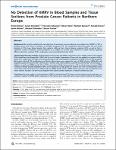No Detection of XMRV in Blood Samples and Tissue Sections from Prostate Cancer Patients in Northern Europe.
Stieler, Kristin
Schindler, Sarah
Schlomm, Thorsten
Hohn, Oliver
Bannert, Norbert
Simon, Ronald
Minner, Sarah
Schindler, Michael
Fischer, Nicole
Background: We recently published the rare detection of xenotropic murine leukemia virus-related virus (XMRV) (1/105) in prostate cancer (PCA) tissue of patients in Northern Europe by PCR. The controversial discussion about the virus being detected in PCA tissue, blood samples from patients suffering from chronic fatigue syndrome (CFS), as well as from a significant number of healthy controls prompted us to deepen our studies about detection of XMRV infection applying different detection methods (PCR, cocultivation and immunohistochemistry [IHC]). Methodology/Principal Findings: Peripheral blood mononuclear cells (PBMCs) from 92 PCA and 7 healthy controls were isolated, PHA activated and cocultivated with LNCaP cells for up to 8 weeks. Supernatant of these cells was applied to a reporter cell line, DERSE-iGFP. Furthermore, the PBMCs and cocultivated LNCaP cells were tested for the presence of XMRV by PCR as well as Western Blot analysis. While all PCR amplifications and Western Blot analyses were negative for signs of XMRV infection, DERSE-iGFP cells displayed isolated GFP positive cells in three cases. In all three cases XMRV presence could not be confirmed by PCR technology. In addition, we performed XMRV specific IHC on PCA tissue sections. Whole tissue sections (n = 20), as well as tissue microarrays (TMA) including 50 benign prostate hyperplasia (BPH), 50 low grade and 50 high grade PCA sections and TMAs including breast cancer, colon cancer and normal tissues were stained with two XMRV specific antisera. XMRV protein expression was not detected in any cancer sections included. One BPH tissue displayed XMRV specific protein expression in random isolated basal cells. Conclusion: We were unable to conclusively detect XMRV in the blood from PCA patients or from healthy controls and there is no conclusive evidence of XMRV protein expression in PCA, breast cancer and colon cancer tissue sections tested by IHC staining.
Dateien zu dieser Publikation
Keine Lizenzangabe
Verwandte Publikationen
Anzeige der Publikationen mit ähnlichem Titel, Autor, Urheber und Thema.
-
2000-10-01ZeitschriftenartikelLebensmittelassoziierte Virusinfektionen Höhne, Marina; Schreier, EckartBis in die 70er Jahre war die Diagnostik von infektiösen Diarrhöen auf den Nachweis von Bakterien und Parasiten beschränkt, und auslösende Erreger konnten nur in einigen Fällen ermittelt werden. Verbesserte Nachweismethoden ...
-
2015-06-19ZeitschriftenartikelIn Silico Prediction and Experimental Confirmation of HA Residues Conferring Enhanced Human Receptor Specificity of H5N1 Influenza A Viruses Schmier, Sonja; Mostafa, Ahmed; Haarmann, Thomas; Bannert, Norbert; Ziebuhr, John; Veljkovic, Veljko; Dietrich, Ursula; Pleschka, StephanNewly emerging influenza A viruses (IAV) pose a major threat to human health by causing seasonal epidemics and/or pandemics, the latter often facilitated by the lack of pre-existing immunity in the general population. Early ...
-
2015-11-10ZeitschriftenartikelComparison of the Cowpox Virus and Vaccinia Virus Mature Virion Proteome: Analysis of the Species- and Strain-Specific Proteome Döllinger, Jörg; Schaade, Lars; Nitsche, AndreasCowpox virus (CPXV) causes most zoonotic orthopoxvirus (OPV) infections in Europe and Northern as well as Central Asia. The virus has the broadest host range of OPV and is transmitted to humans from rodents and other wild ...

